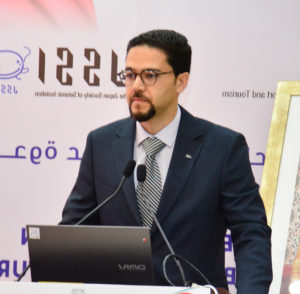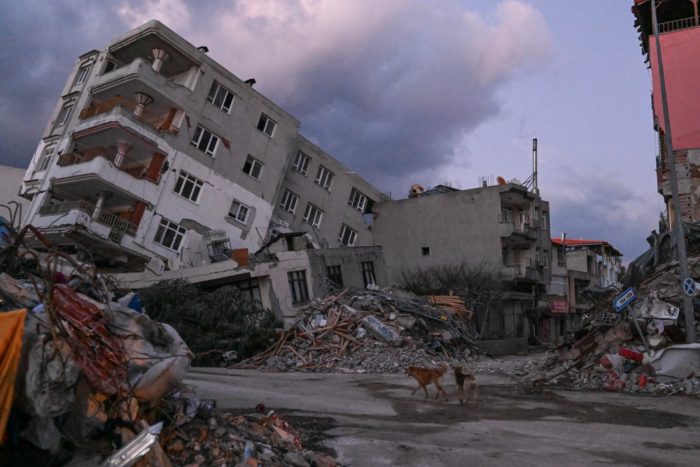(This article, originally published in March 2023 following the earthquake in Turkey, was updated on September 9, 2023)
Soft-story buildings are said to be widespread in Morocco due to their lower cost. According to Nabil Mekaoui, an expert in seismic engineering and a researcher at the Mohammadia School of Engineers (EMI), who completed part of his studies in Japan, explains to TelQuel the vulnerability of this type of construction.
Poorly reinforced concrete

« These buildings typically consist of several floors, with one or more being very flexible horizontally compared to the adjacent floors. When this type of construction is exposed to a horizontal force, such as during an earthquake, the soft-story floors experience significant deformations that can threaten the stability of the building’s load-bearing elements, such as columns and beams.
This situation is very common at ground floors, often intended for commercial use (cafés, shops, garages, etc.) and designed with architecture that requires less infill masonry than the upper floors, making them less rigid. In the event of an earthquake, the upper floors move as a rigid block, while the soft ground floor deforms or collapses, increasing the risk of a total building collapse and causing considerable human and material losses. »
“This type of collapse traps survivors under heavy construction materials, making rescue missions even more difficult.”
And Nabil Mekaoui adds: « This type of collapse traps survivors under heavy construction materials, making rescue missions even more difficult. »
History confirms that soft-story buildings perform very poorly during strong and moderate magnitude earthquakes. For example, during the 1994 Northridge earthquake in California, which had a magnitude of 6.7, almost all soft-story buildings collapsed, resulting in 70 deaths and the destruction of 40,000 homes.
Similarly, during the Chi-Chi earthquake in Taiwan in 1999, with a magnitude between 7.6 and 7.9, many structures similar to California’s buildings suffered complete collapse due to their soft stories, killing over 2,400 people and destroying more than 9,900 buildings.
In Morocco, where seismic activity is relatively moderate, the vulnerability of buildings, especially those with soft stories, has already caused significant damage during earthquakes. For instance, the 1960 Agadir earthquake (magnitude 5.7) resulted in the death of over 12,000 people and the destruction of 75% of the city. More recently, the 2004 Al Hoceima earthquake (magnitude 6.3) killed more than 620 people and destroyed over 2,500 buildings.
« Morocco is particularly vulnerable »
“Even though one might say that the seismic risk in Morocco is moderate, the vulnerability is far from it. That is precisely where the problem lies”
Contacted by TelQuel, the Global Earthquake Model (GEM) Foundation, a nonprofit organization launched in March 2009 by the OECD’s Global Science Forum, confirmed that the seismic risk in Morocco stems primarily from the vulnerability of its buildings. “Even though one might say that the seismic risk is moderate in Morocco, the vulnerability is far from it. That is precisely where the problem lies,” highlights the GEM Foundation, a leading authority on estimating the potential human, social, economic, and financial damages from earthquakes.
They further specify: “If we take into account the population density in the most seismic areas of the country—where most of the nation’s wealth is concentrated—and add the presence of vulnerable buildings, especially those with soft stories in the region, we face a high risk of human and material damage that could destabilize the country’s economy.”
The GEM Foundation’s calculations are based on each country’s social indicators, historical seismicity, and the vulnerability of buildings and infrastructure.
“We remind you that people do not die from an earthquake, but from the collapse of buildings it causes. It is better to prevent than to bury”
« What emerges from our analysis of Morocco is that this country is particularly vulnerable. Hence the importance of a prevention and anticipation strategy to reduce losses, especially through the implementation of seismic regulations that are rigorously enforced. We remind you that people do not die from an earthquake, but from the collapse of buildings it causes. It is better to prevent than to bury, » emphasizes the NGO.
How can future tragedies be avoided? According to our sources, the answer lies in the proper design and construction of buildings, particularly multi-story ones, as well as stricter enforcement of seismic standards, which are not systematically applied in all regions of the country.
« Morocco, like other countries near fault lines such as Turkey, can all be subject to more or less intense earthquakes, but these disasters might not be as deadly if authorities strictly enforce seismic codes and establish ‘safe housing’ as a human right, » explains the GEM Foundation.

Unanswered questions
At the national level, an initial regulation was imposed within the urban perimeter of Agadir after the 1960 earthquake, but it wasn’t until 2002 that a decree on seismic construction (RPS 2000) and the establishment of a seismic zoning for Morocco was adopted. This text was revised and improved in 2011 for better applicability.
A second natural disaster prevention plan was launched by the kingdom after the 2004 Al Hoceima earthquake. But the main issue lies in the enforcement and monitoring of these regulations, our sources emphasize.
“The organizations responsible for overseeing compliance with seismic standards in Morocco, which have the technical expertise for this purpose—technical control offices—do not yet have a legislative and regulatory framework clearly defining the terms of their intervention in the building process. They generally intervene within the framework of decennial liability insurance (an insurance contract primarily covering damages related to the building’s structural integrity), and the authorization to practice their profession is granted by reinsurance companies,” regrets Nabil Mekaoui.
Another point that raises concern: if a seismic regulation was only adopted in Morocco in 2002, does that mean all buildings constructed before that date are at risk of collapsing with the slightest tremor? One thing is certain: it is very difficult to assess the seismic resistance of buildings in Morocco or to determine the proportion of soft-story buildings across the country.
In the absence of official figures, TelQuel attempted to obtain answers from the Ministry of Territorial Development, Urban Planning, Housing, and City Policy. As of the time we went to press (March 2023, editor’s note), no response had been received by the editorial team.
“An assessment of the extent of seismic vulnerability in existing buildings in Morocco must be conducted to truly evaluate the seismic resistance of structures across the country”
“An assessment of the extent of seismic vulnerability in existing buildings in Morocco must be conducted to truly evaluate the seismic resistance of structures across the country. A regulation for seismic evaluation and reinforcement should be established and used for this purpose. Theoretically, seismic risk has been mitigated in post-2002 constructions, as adherence to the regulation has become mandatory since then. For all buildings constructed before that date, it will be necessary to establish Morocco’s first regulation for the seismic evaluation and reinforcement of existing buildings,” advises Nabil Mekaoui.
The National Council of the Order of Moroccan Architects called on the profession, in a letter, to comply with seismic construction regulations and the requirements for earthquake-resistant buildings and civil engineering structures.
For her part, the Minister of Housing, Fatima-Ezzahra El Mansouri, announced that her teams had mapped the province of Al Hoceima.
“An assessment of potential losses in the event of an earthquake was even conducted as a preventive measure. An approach aimed at integrating the conclusions of the studies into the urbanization strategy for the entire province, as well as for other urban centers, particularly regarding urban planning, has also been adopted.
In addition to Al Hoceima, we have also focused on the case of Agadir. Extensive work is being carried out on the urban planning regulations for this area, including the Urban Master Plan (SDAU). Special attention is being given to the implementation of the regulatory provisions decided by the public authorities, who have chosen to prioritize anticipation,” the minister responded to parliamentarians who, after the Turkey earthquake, asked if her department had anticipated seismic risks in certain regions. An early warning system?
Written in French by Manal Zainabi, edited in English by Eric Nielson
Security
How can you ensure that your home (whether current or under construction) complies with seismic standards?
By consulting a certified engineering or inspection firm, or of course, a seismic engineering expert, Nabil Mekaoui explains. They can verify whether the structure complies with the standards.
This technical service is obviously easier and more cost-effective to perform during the design and construction phases of a building. However, it is also possible to have a home inspected before purchasing, renting, or deciding to move.



